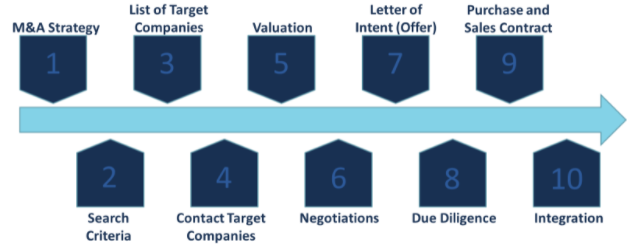Four Principles for a Successful M&A Due Diligence
Global Merger and Acquisition (M&A) activity quickly heated up in 2021, driven by low-interest rates, seller concerns about anticipated tax law changes, and perhaps a bit of pent-up demand coming out of the economic lockdowns. According to Refinitiv data, the total value of pending and completed deals announced from the January-May period touched $2.4 trillion, an all-time record. Though today’s M&A value proposition is massive, the potential risk is just as staggering. Numerous studies indicate somewhere between 70% and 90% of deals fail to achieve the expected value.
Several points in the M&A process can contribute to the failure, but experts often point to gaps in the due diligence efforts. This article will provide a broader explanation of acquisition due diligence, its part in overall M&A, and share four principles that form the foundation for a successful diligence process.
Brief Introduction to M&A Process
The diagram below depicts a typical corporate M&A process. Since the focus of this article is on due diligence, we will not detail the steps that are taken to identify specific acquisition candidates. Once there is agreement on price/terms (Step 6) between the buyer and seller, a letter of intent (Step 7) will be signed, and due diligence (Step 8) will commence. At this point, leaders of the acquiring organization must ensure a complete and comprehensive due diligence review of the target entity to fully understand the issues, opportunities, and risks associated with the transaction and ensure the accuracy of information obtained earlier in the process.

What is Merger/Acquisition Due Diligence?
Due diligence is a process of verification, investigation, or audit of a potential deal. Relevant facts and financial information are provided by the seller for the buyer and their advisors for verification. The materials provided by the seller will generally be transmitted using a “virtual data room” or simply a shared electronic folder. A typical due diligence team will include internal and external functional experts (e.g., operations, sales, finance, HR, IT, etc.) and external legal, accounting/finance, and tax advisors. The period to conduct diligence can last anywhere from a few weeks to many months, but 30 to 60 days is standard for companies with experience in M&A.
The purpose of M&A due diligence is for the buyer to:
- Ensure the deal complies with the investment or deal criteria, and uncover facts and risks that significantly impact the overall deal, such as those that would lead to:
- a decision to abandon the acquisition
- a reduction in purchase price or the requirement for funds to be placed in escrow (or other agreements) to cover known or potential risks
- Learn facts or risks that require mitigation/actions (pre or post-deal close), contribute to synergies, or raise acquisition/integration costs. Examples include:
- required upgrades to systems, equipment, or facilities
- contract novation/assignment or need for Transition Services Agreements (TSA)
- notifying or receiving approval from governmental authorities
TIP: Treat due diligence and post-merger integration like a project – apply proper governance, detailed role definitions, ample task tracking, appropriate status reporting, etc.
Why Does Due Diligence Matter?
Acquisitions that undergo thorough due diligence offer higher chances of success for a multitude of reasons. Due diligence also allows the buyer to feel more comfortable that expectations regarding the transaction are accurate. It also reduces the risk by identifying areas that require immediate or future action and enables the development of a plan to address or mitigate. Finally, the due diligence period should offer a jumpstart into integration, offering an invaluable time for leaders of both organizations to set expectations around the level, nature, and timing of Post-Merger Integration (PMI).
Foundation of a Successful Due Diligence
Given the high failure rate for corporate acquisitions and the significant risk undertaken, buyers should approach due diligence with appropriate internal structure and process. These four principles form the basis for a successful due diligence process:
- The entire due diligence team must understand the deal’s strategic rationale and use it to guide their decision-making during diligence and integration planning.
- The scope of diligence should include matters beyond financial performance, tax compliance, and legal technicalities. Disciplines often left out or where diligence is limited include human capital risks, commercial viability, business continuity, and cybersecurity risks.
- The depth of diligence must be appropriate for the size of the acquisition and the potential risks associated with the transaction.
- Integration planning begins early and certainly before the deal closes.
Tip: Create standard functional output with observations, risks, issues, decisions, and quick wins.
- Successful Due Diligence Foundation: Strategic Rationale
The strategic rationale answers the question “why do the deal?” and should be developed during the “search criteria” (step two) of a typical M&A process. It is critical that the due diligence team understands the deal’s strategic rationale and uses it to guide decision-making during diligence and eventual integration planning. For example, if the rationale is for economies of scale, the focus for diligence would be to identify cost savings opportunities and understand the level of investment required to meet corporate standards. The strategic rationale for a specific acquisition typically conforms to one or more of the following five objectives:
- acquiring skills, technologies, or locations/facilities more quickly or at a lower cost than they could be built in-house
- creating market access for products
- exploiting economies of scale
- improving the performance of the target company
- investing early in the life cycle of a new industry/product line/etc.
TIP: Develop high-level synergies with quantified targets that align with and support the strategic rationale.
- Successful Due Diligence Foundation: Scope of Diligence
A comprehensive diligence process examines numerous aspects of the company, with specific focus on the areas listed below. The relative importance will vary based on company, strategic rationale, and deal type; however, the disciplines in the column on the right often do not receive the same level of rigor as those on the left. Future articles in this series will cover specific areas to be addressed within the scope of diligence in some of these disciplines.
| Organization and Ownership Compliance and Regulation Accounting/Financial Tax Operational Commercial Legal Intellectual Property | Administrative Physical Assets Information Technology Cybersecurity Human Resources Environmental Strategic Cultural Alignment |
- Successful Due Diligence Foundation: Depth of Due Diligence
Every M&A deal is unique — and the depth of due diligence needed for each functional discipline will vary depending on the target, the strategic rationale, and the dynamics of the deal. The desired depth dictates the time spent on diligence, the volume of questions asked, the number of participating team members (internal and external), and the effort to process and analyze the information provided in the dataroom. The correct depth for a specific transaction will allow team members to gain enough knowledge to uncover facts and risks that significantly impact the overall deal.
In most companies, the deal’s lead or sponsor generally dictates the timeline and expectations regarding the depth of diligence. However, each functional area lead will need to consider what is appropriate for their discipline for the specific deal. While most buyers will prioritize their requests, acquisition targets will often focus on sharing the information that paints them in the most attractive manner first, and defer providing documents that show shortcomings. To overcome this, a common technique buyers will use is to segment their full standard request list into batches or waves. The diligence team should also consider if multiple topics or questions can be addressed more readily via a call or meeting with members of the seller’s team.
Tip: Leverage all available tools for remote diligence – virtual tours, video conferences, online diligence request list, etc.
- Successful Due Diligence Foundation: Early Integration Planning
Maximizing the potential of an M&A transaction poses complicated and unique challenges since no two deals are alike. However, clearly defining and managing post-merger integration activities is one of the most important elements of a successful transition and can drive the deal’s ultimate success while minimizing risk and avoiding missed opportunities or unintended consequences.
At a minimum, a high-level integration plan identifying milestones by major increments (Pre-Close, Day 1, First 30 Days, First 90 Days, First Year, etc.) should be in place and shared with the acquisition target’s leadership prior to close. Ideally, a detailed task-level plan can be created quickly once functional leaders from both the target and the acquirer connect to confirm the dependencies to/from the other functional disciplines and timing.
For repeat acquirers, the plan used for past acquisitions will serve as a useful starting point for the next integration. If you are developing an initial plan, use the following considerations to help guide you and refine the plan in consultation with functional and executive leadership:
- What needs to be addressed quickly? (Day 1 or First 30 Days). This will generally include implementation of controls such as bank account access, systems access, etc., and internal and external communications (employees, customers, suppliers, partners, etc.).
- For each potential process, system, policy, etc., is the desire to align/harmonize, fully transition to the acquirer’s standard, or to leave alone?
- Is enough known to define the necessary actions? If not, add a step to assess or evaluate the area in greater detail preceding the step to make the transition.
- Ensure necessary dependencies are incorporated, especially those between different functional areas. For example, new employee cost centers may need to be created in the finance system before the first integrated payroll cycle.
- Ensure all required activities are included – such as training before new systems launch.
- Incorporate a cultural assessment to evaluate cultural nuance and devise plans to meld cultures.
Tip: Consider culture in two ways: what differences in culture exist between the organizations participating in the transaction, and what is the desired future state of the new organizations. These considerations vary based on the type of transaction – for example, is it intended to be a basic tuck-in or a more transformational integration.
Conclusion
M&A is a risky endeavor for companies, but it can also be extremely lucrative by providing access to new markets, products, technology, and skills more quickly than they can be developed internally. While the due diligence process is a likely source of risk, teams that are equipped with a firm understanding of the process and that follow the four principles outlined in this article are more likely to avoid major pitfalls and achieve success.
Future articles in this series will address the unique needs for diligence in areas such as Human Resources, Information Technology, Cybersecurity, and Accounting processes.
With over 100 M&A projects executed, CREO offers our clients a proven track record of reducing risk and realizing value through Due Diligence Management and Post Merger Integration. As a novel management consulting firm with deep expertise in health, life sciences, and tech services, we combine a unique blend of M&A, executive leadership, coaching, operations, technical, process, and execution capabilities to maximize the value of each growth opportunity. Contact us to learn more about how we can help you evaluate and execute successful inorganic growth opportunities that add value, generate returns, and achieve ambitious business goals.



